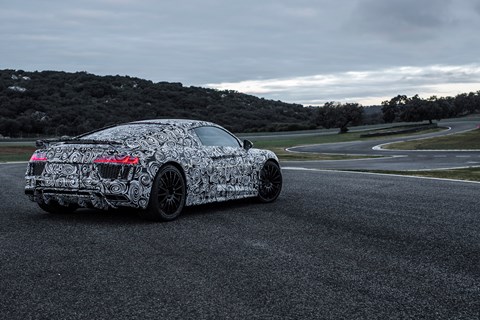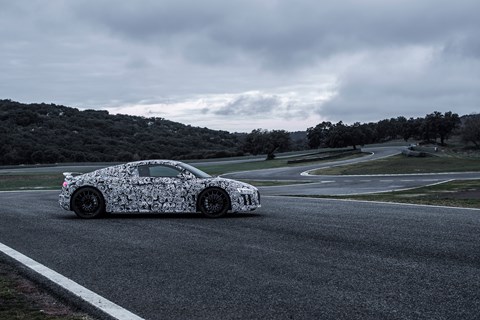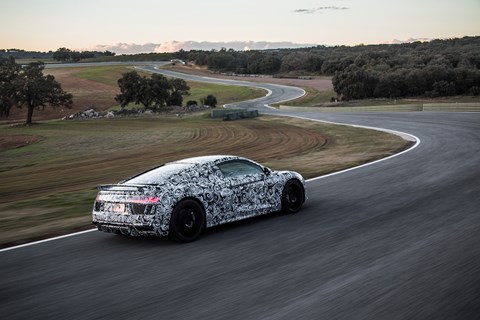► CAR rides shotgun in new Audi R8
► V10+ tops 205mph, 0-62mph in 3.2sec
► Regular V10 makes 533bhp, V10+ 602bhp
Audi will unveil an all-new R8 supercar at the 2015 Geneva motor show in March. How will it follow up such a successful model? We’ve been to the Ascari race resort in Spain for a sneak peek – and a passenger ride – in an effort to find out.
New 2015 Audi R8: design
The new R8 will not be a radical departure from the old car in terms of design – this is an Audi, after all. But like the latest TT, the new R8 features sharper lines and a pointier nose, both features that the swirly camouflage does a surprisingly good job of disguising, even in the metal. The slightly cab-forward stance remains recognisably R8, either way, and the new car’s dimensions are almost identical to the old one’s.
The wheelbase is actually identical at 2650mm, and we understand that the track width is also the same despite the new chassis, which incorporates an all-new front axle design and revised steering set-up. The pointy nose means it’s slightly longer, with a larger 104-litre luggage storage area, shaped to swallow aircraft cabin baggage. The passenger compartment is also 30mm wider, and the seating position is 30mm lower, creating a greater feeling of space. There is, apparently, enough room for a set of golf clubs behind the seats; as before the R8 will only carry two.
New 2015 Audi R8: performance
In a complete turn-around from the first generation, which launched with a V8, Audi will launch the V10 and the V10+ first this time, and is remaining tight-lipped about what other variants will be made available over the new R8’s lifecycle (we’ll come back to this below). That fixed rear wing denotes that the cars pictured here are the range-topping V10+ model; the regular V10 has an active rear spoiler instead, the only active aerodynamic aid on the entire car, even though it now generates more downforce.
The V10 engine is a development of the wholesome 5.2-litre naturally aspirated unit from the previous R8. In standard guise it produces 533bhp, up some 15bhp while the V10+ now produces 602bhp. This is not only a substantial increase over the previous 543bhp, and even the 562bhp of the limited edition R8 LMX end-of-run model, it’s exactly the same amount as the Lamborghini Huracan LP610-4.
As with the Gallardo before it, the Huracan is the new R8’s exotic cousin – but that does not mean they are exactly the same car. The R8 has a 30mm longer wheelbase and has been engineered to be more of an ‘everyday’ car. Everything from the ride comfort to the engine calibration and the behaviour of the standard-fit four-wheel drive system is different in the Audi. Overall head of the R8 project, Roland Schala repeatedly describes the Huracan as a ‘beast’, a politically astute term with a variety of connotations; he seems confident that the R8 won’t be regarded as the poor relation, that’s for sure.

In contrast to its predecessor, the new R8’s four-wheel system has no nominal torque split, and is instead 100% variable front to rear. Exactly how this behaves is dictated by the driving mode. Like in regular Audis, the new R8 offers Comfort, Dynamic, Auto and Individual settings for the throttle response, gearbox, steering and – where fitted – the magnetic ride suspension; in addition to this, however, there’s a Performance button on the steering wheel that offers optimised settings for going as quickly as possible in Snow, Wet or Dry conditions. Yes. That’s a Performance setting for snow.
As for the raw figures, the new R8 V10+ will go 0-62mph in 3.2sec, 0-124mph in 9.9sec and has a top speed of 330kmh, or 205mph! Maximum torque is 413lb ft, while fuel economy is a claimed 22.8mpg with 289g/k CO2. Audi is waiting for better weather and series production tyres and chassis settings before establishing a benchmark Nürburgring time, but promises the new car will be significantly faster…
New 2015 Audi R8: interior
One of the reasons Audi invited us to Ascari was privacy – it didn’t want any spy photographers getting a snap of the interior. So although we’ve seen it undisguised on the inside, we aren’t allowed to show you any pictures yet. Partly because the cars on hand we pre-production, partly because it wants to save something for the Geneva unveiling.
The interior of the original R8 was often criticised for recycling too many parts from other Audis, so this time it is far more bespoke. The overall architecture isn’t too different, but like the latest TT the new R8 has binned off the central display in favour of the Virtual Cockpit digital dashboard. This is very slick, and can be tailored to display information according to your preference, with a Classic two dial set-up and Sport display with large central rev counter and the option to permanently show other useful items such as tyre pressure (and less useful ones, like a g-meter).
Audi has moved as many controls as possible on to the steering wheel, using four circular buttons. Two of these cover all the usual infotainment and display controls, while one of the smaller two is the dial for the Performance settings and the other is dedicated exclusively to the exhaust. That’s right, Audi believes the sound of its supercar is so important there’s a button just for that on the steering wheel. No wonder the firm is reluctant to abandon the big, characterful V10 in favour of smaller, dead-sounding turbocharged alternatives.
It’s not all good news. There’s a trio of disappointments, all related to the gearbox. First, there is no manual option – it’s a seven-speed twin-clutch S tronic only, like the Huracan. The advantage of this is full-bore flat-shifting in the maximum performance modes for furiously seamless acceleration, something we can certainly testify to (more of which later). The paddles on the steering wheel, however, are currently the same pathetic plastic items used on other Audis; we’re told this will change for production, and here’s hoping, because this is a vital point of interaction with the car. Thirdly, Audi has elected to keep the lever-operated manual change oriented like the rest of the range, rather than in the sequential pull-back-to-change-up, push-forward-to-change-down manner of a true performance (and racing) car. Ho-hum…
New 2015 Audi R8: CAR rides shotgun on track in the passenger seat
We weren’t allowed to drive the new R8 on this occasion, but we were taken for a quick couple of laps of Ascari but Audi development and racing driver, Frank Stippler. Suffice to say, this former Nürburgring 24-hour race winner doesn’t hang around. In fact, we can’t remember the last time we felt as physically uncomfortable under acceleration as we did leaving the pitlane in the V10+. This thing can really move – that the pitlane leads straight out onto an off-camber downhill left-hander only added to the experience. The swearing was honestly involuntary.

What can you tell from the passenger seat? A fair amount. Frank is clearly working the car hard, and it’s moving around a lot under extremes of braking and cornering, but it does so with a fluid ease rather than a snappy I’m-trying-to-kill-you vibe. Steering inputs on this variable ratio steering car are notably constrained, meaning he’s working less hard to manage everything, though purists will be pleased to know that a non-variable rack is also offered, and requires fewer turns lock-to-lock than before, too. He’s also back on the power very early in the corners – the joy of that 100% variable four-wheel drive – so even when he’s neatly provoking oversteer using a bit of trail braking into some of the tighter turns, helped along by the standard mechanical limited slip differential, it’s clear the R8 just wants to get on with it, rather than proving itself obstinate.
The goal, Frank says, was to build a new R8 that was more comfortable but faster, especially on track – not easy, but apparently achievable. The test car is on the standard suspension, rather than the optional Magnetic Ride variable system, which offers a greater range between comfort and sportiness, but it still absorbs Ascari’s kerbs with barely a ruffle. Don’t expect quite the same if you clout the pavement in Clapham, but the point is you hopefully won’t need to dodge potholes with the degree of determination required in the previous version, and long-distance motorway trips should be a cinch.
New 2015 Audi R8: structure
How do you make a car faster yet more comfortable? The trick is to start by improving the structure. Based on the same blend of aluminium spaceframe with carbonfibre for the transmission tunnel and firewall as the Huracan, the structure of the new R8 is a massive 40% stiffer than the old one – while also being lighter. This allows the suspension to do its job much more effectively, allowing Audi’s engineers to make it softer while increasing its performance.
Why isn’t it all carbon, you might ask? Not just because of the higher cost. Audi (and Lambo) chose to use what it believed to be the right materials for the right job, whether than be carbon, aluminium or steel. This is the reason there’s no carbon roof; there just wasn’t enough of an advantage over metal to make it worthwhile. Certainly the weight difference would be negligible.
All told, the new R8 V10+ weighs 1454kg dry and 1555kg wet (without a driver), 15% less than before. Other details include standard carbon-ceramic brakes (for the V10+), 48:52 front:rear weight distribution and 19-inch wheels as standard. 20-inch wheels with semi-slick tyres are an option. All the tyres offered are bespoke compounds for the R8 (though this process is no different to other Audi models).
New 2015 Audi R8: rivals, pricing and the future
We asked the project leader which other supercars he saw as the main rivals for the new R8, and he simply replied ‘all of them’. Audi’s intention is to take on the very best with this car, and that means everything from the Porsche 911 Turbo to the McLaren 650S – and presumably even the Ferrari 488 GTB. The naturally aspirated V10, with its immediacy, linearity and sensational noise, shouldn’t be short of fans in an upper-echelon world increasing dominated by less sonorous turbocharged muscle. But the previous R8’s real genius was in the way it combined those outstanding looks with an easy-to-drive nature and a sense of excitement at any speed – if the new one continues in this vein success is assured. First drives are currently scheduled for mid-July 2015.
As for pricing, we’re told the new R8 V10+ should be roughly in line with the outgoing LMX, which cost £160,000 in the UK. Not a bad deal considering the extra power and performance, but what about a more affordable entry-level model?
Smaller-engined R8s definitely aren’t out of the picture entirely; the question mark is over exactly what form they will take. Will the much-loved naturally aspirated 4.2-litre V8 make a return? Well, possibly. But with repeated references to the needs of the Chinese market by Audi personnel, there’s a strong sense that something else may be planned. China’s taxation regulations are based on capacity, so if Audi can deliver an R8 with a smaller engine – perhaps 4.0 litres or less – still, that would be a definite advantage. Would that engine then be bolstered by the turbochargers Audi currently seems so keen to avoid? Don’t bet against it.
Other future variants include a possible production R8 E-Tron, which would be all-electric – and rear-wheel drive only. Don’t get too excited: the Audi people on hand at Ascari seemed unconvinced that the weight of an electric drivetrain could deliver true sporting performance, regardless of how many wheels are driven. But then, they do need to make sure the V10 gets off to a good start…
That isn’t the end of the story for rear-wheel drive R8s, however. Development of the road car has been undertaken in parallel to the racing car this time around, a process through which both are said to benefit. One upshot of this is the potential for a hardcore, 911 GT3-rivalling R8 variant, for example. The other is a deadly serious assault on the 2015 Nürburgring 24-hours, which Audi is aiming to win with the R8, first time out.
